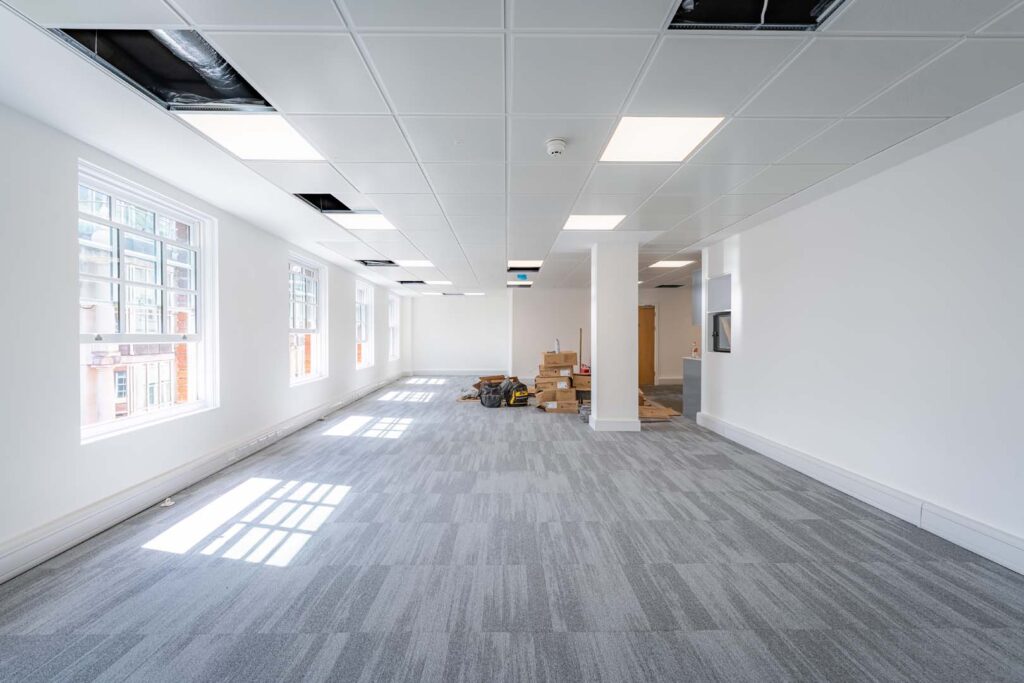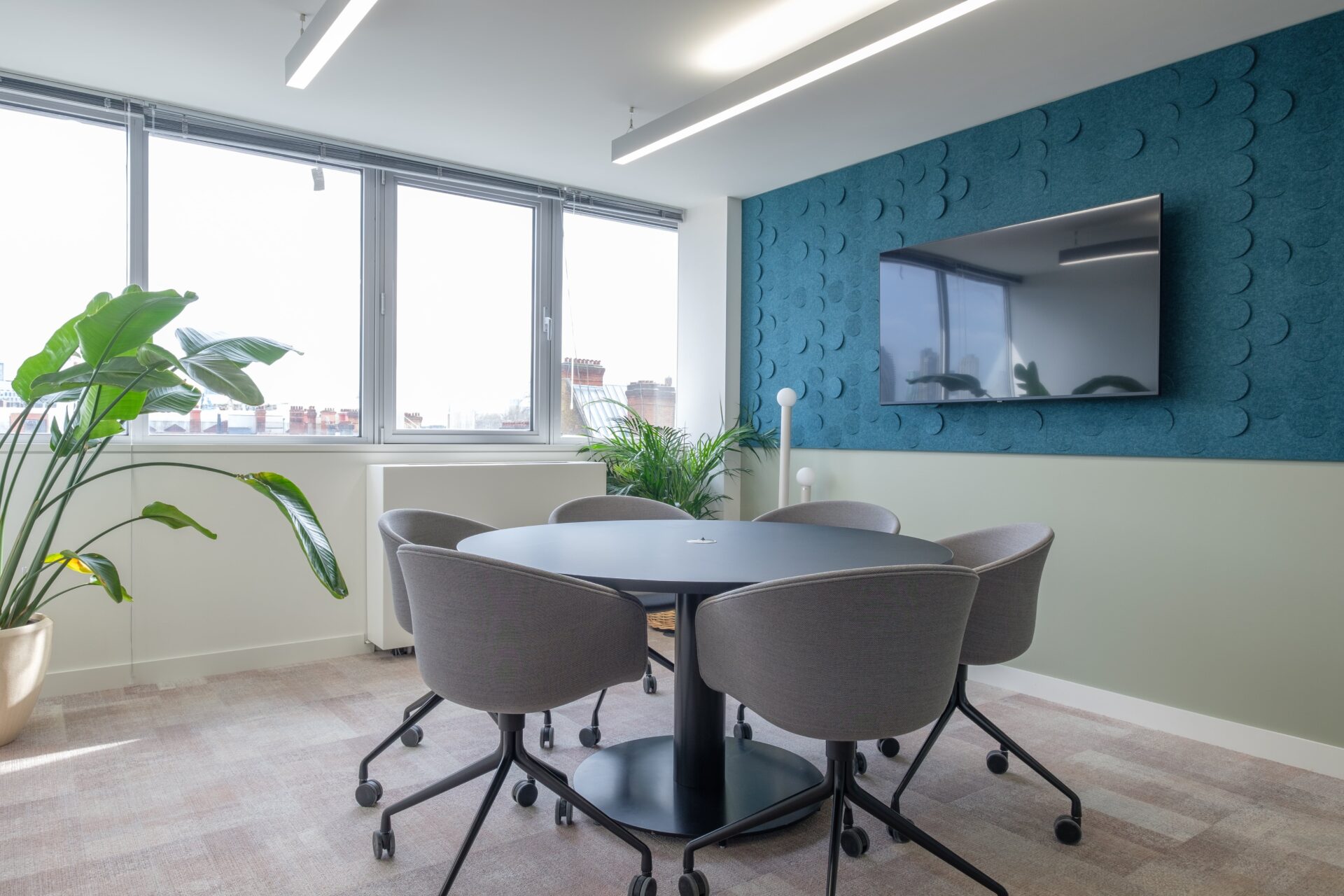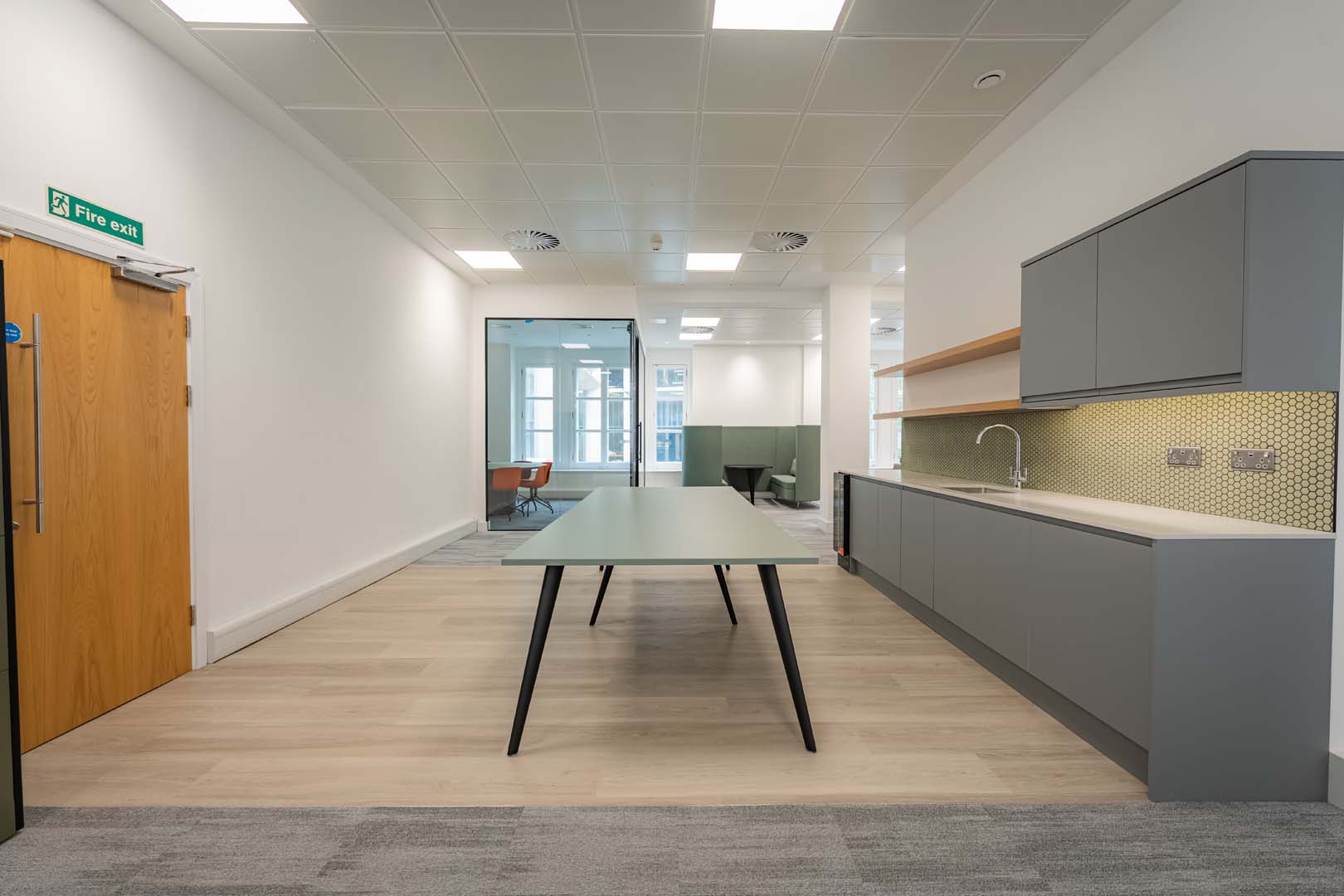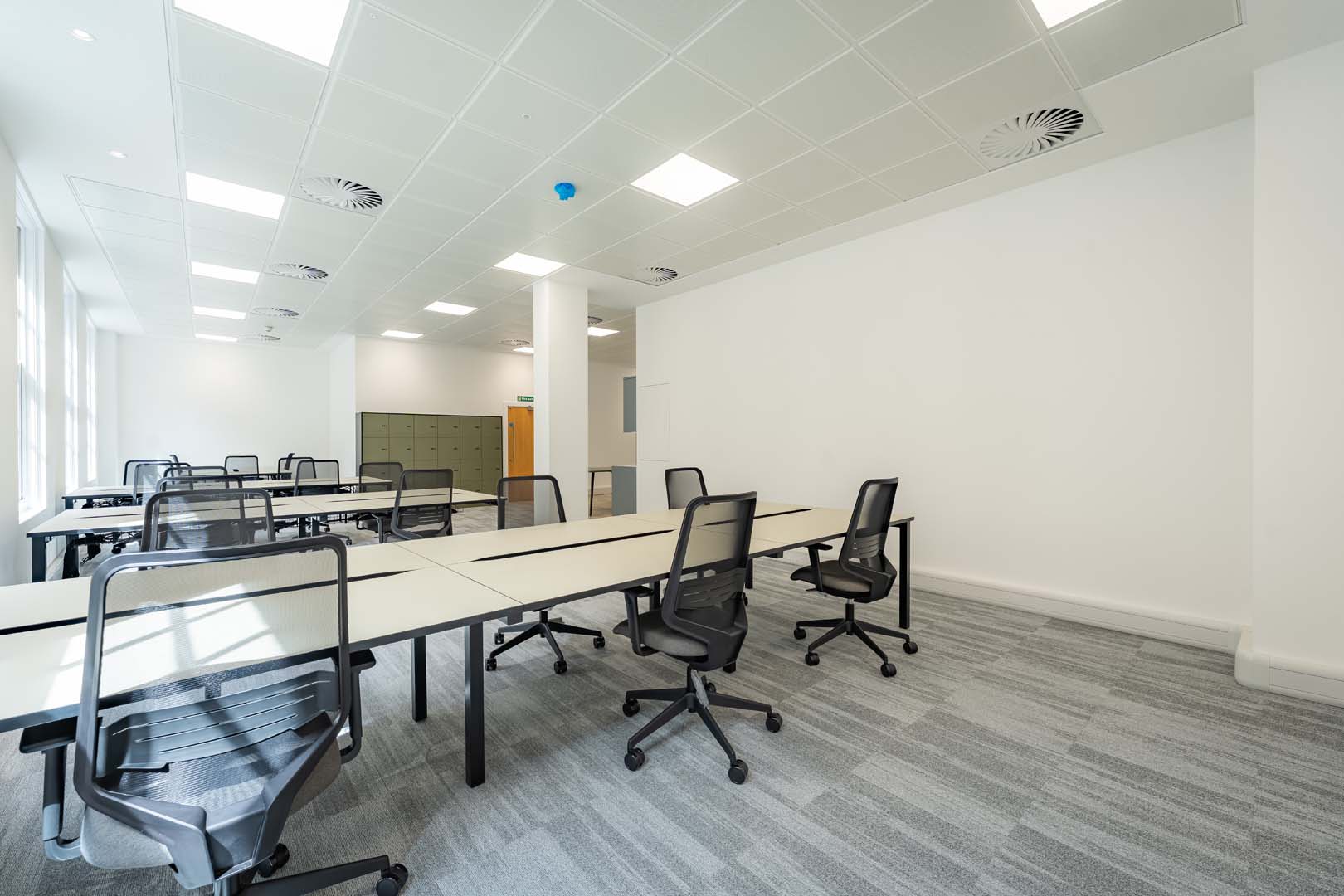Navigating an office refurbishment project begins with understanding exactly what work will be performed, by whom, and to what standard.
The office refurbishment scope of work serves as the foundation document that defines every aspect of your project, from initial demolition to final handover. The office refurbishment journey is a structured, step-by-step process that guides clients through transforming their workspace, ensuring clarity and collaboration at every stage.
For modern businesses, creating adaptable and collaborative work environments is essential to support productivity, creativity, and employee well-being in today’s fast-evolving workplace.
Understanding Your Office Refurbishment Scope of Work Document
An office refurbishment scope of work is a detailed document that outlines the work that will be performed under a contract, describes the project’s requirements, defines the work that needs to be done, lays out who is responsible for completing each task, and establishes timelines.
Defining the project scope is essential for accurate planning and execution, ensuring that all aspects of the refurbishment are considered from the outset. This critical document transforms your vision into actionable, measurable deliverables that contractors can price accurately and execute professionally.
The scope of work acts as your project’s roadmap, ensuring all parties understand expectations before work begins. It eliminates ambiguity about what’s included in your contract price and what constitutes additional work. A well-defined office refurbishment scope of work protects your interests by establishing clear performance standards, delivery timelines, and quality expectations. It also helps establish a realistic budget for the project by identifying all necessary phases and potential contingencies. It serves as the primary reference document for resolving any disputes that may arise during the project lifecycle.
Essential Components Every Scope of Work Should Include
A comprehensive office refurbishment scope of work encompasses multiple interconnected elements that collectively define your project’s parameters. Understanding these components enables you to evaluate contractor proposals effectively and identify potential gaps that could lead to problems later.
Project Overview and Objectives form the foundation of your scope of work. This section should provide a clear description of your current space, desired outcomes, and specific business objectives driving the refurbishment. Include details about your company culture, working patterns, and any unique requirements that influence design decisions. As part of the initial assessment, be sure to identify key pain points within your workspace and consider how the refurbishment can address them, while also ensuring the design reflects your brand identity.
Detailed Work Descriptions break down every aspect of the refurbishment into specific, measurable tasks. This includes demolition work, construction activities, mechanical and electrical installations, decorative finishes, and furniture installation. Each element should specify materials, quality standards, and performance criteria. Incorporate space planning to optimise office layouts, support workflows, and enhance collaboration.
Technical Specifications provide the detailed requirements for all systems, materials, and installations. This includes flooring specifications, lighting requirements, HVAC parameters, electrical capacity, data infrastructure needs, and any specialised equipment installations. The more specific these requirements are, the more accurate your contractor’s pricing will be. During the design development phase, use mood boards to visually align stakeholder visions and facilitate decision-making on finishes and style.
Project Timeline and Milestones establish when work will commence, key completion dates for different phases, and the final handover date. Include provisions for progress reviews and approval stages that may affect the timeline. A clear timeline ensures nothing important is overlooked during the refurbishment process.
Structural, Building Services, and Energy Efficiency Elements
The structural and building services components of your office refurbishment scope of work typically represent the most technically complex and costly elements. Understanding what should be included helps you evaluate contractor capabilities and ensure adequate coverage for your needs.
Demolition and Removal Work should specify exactly what existing elements will be removed, how materials will be disposed of, and what protection measures will be implemented for retained features. This includes partition removal, ceiling dismantling, floor covering removal, and clearing of redundant services.
Structural Modifications encompass any changes to load-bearing elements, floor openings, or building fabric alterations. Even seemingly minor structural changes require proper engineering assessment and building control approval. Your scope should clearly identify who holds responsibility for obtaining necessary permissions and certifications. Ensure all modifications comply with current building regulations to meet legal and sustainability standards.
Mechanical and Electrical Services represent critical infrastructure that supports your daily operations. The scope should detail HVAC modifications, electrical capacity upgrades, lighting installations, emergency systems, and any specialised equipment requirements. Include energy-efficient lighting as part of your sustainability goals. Include provisions for testing and commissioning to ensure all systems operate correctly.
Plumbing and Drainage work often extends beyond obvious areas like the kitchen and washroom facilities. Consider requirements for plant rooms, cleaning cupboards, and any process-specific water needs. Specify quality standards for fixtures and fittings that align with your overall design aspirations, and select eco-friendly materials where possible.
Interior Finishes, Brand Identity, and Aesthetic Considerations
The interior finishes section of your office refurbishment scope of work defines the visual and tactile qualities of your completed space. These elements significantly impact both the project cost and the daily experience of your workspace users. Interior finishes also play a crucial role in the visual appeal of your office, helping to create a modern, inviting, and professional environment.
From natural light to cutting-edge technology, a well-designed office requires consideration of the space usage, employee productivity and how project managers can keep the business running smoothly and monitor progress throughout the refurbishment project.
Flooring Specifications should detail not only the type and quality of floor coverings but also substrate preparation requirements, transition strips, and any specialist installations like raised access floors. Consider maintenance requirements and lifecycle costs when specifying materials.
Wall Finishes and Partitioning encompass everything from paint specifications to specialist wall coverings, glass partitions, and solid partitioning systems. Include acoustic requirements, fire ratings, and any branding elements that need integration into wall systems.
Ceiling Systems involve more than just aesthetic considerations. Specify acoustic performance, access requirements for services, lighting integration, and any suspended elements. Include provisions for coordination between ceiling contractors and services engineers.
Doors and Hardware requirements should cover both functional and security needs. Specify access control integration, fire door requirements, and any specialist hardware needed for your operations. Include provisions for master key systems and electronic access integration.
Thoughtful selection and integration of finishes can breathe new life into your office environment, rejuvenating the workspace and positively impacting company culture.
Technology Infrastructure and Smart Systems
Modern office refurbishment scope of work documents must address increasingly sophisticated technology requirements. These systems often represent significant investments that require careful planning and coordination with other building services. Integrating advanced technology can enhance productivity and efficiency in the workplace, supporting both operational growth and regulatory compliance.
Data and Communications Infrastructure form the nervous system of modern offices. Your scope should specify cable pathways, distribution points, wireless infrastructure, and provisions for future expansion. Include requirements for redundancy and disaster recovery capabilities.
Audio-visual systems have become integral to modern workplace functionality. Specify requirements for meeting rooms, presentation areas, and collaborative spaces. Include provisions for video conferencing, digital signage, and any broadcast or recording capabilities.
Security and Access Control Systems require integration with building infrastructure and careful consideration of operational requirements. Specify CCTV coverage, access control points, alarm systems, and any specialist security measures relevant to your business.
Smart Building Technology, including automated lighting, climate control, and space utilisation monitoring, represents growing components of refurbishment projects. Consider both immediate benefits and future scalability when defining requirements.
Furniture, Fixtures, and Equipment Considerations
The furniture, fixtures, and equipment (FF&E) component of your office refurbishment scope of work significantly influences both functionality and aesthetics. This section requires careful consideration of operational requirements, budget constraints, and long-term adaptability. Selecting the right FF&E also supports a flexible working environment, enabling your office to adapt to evolving business needs and employee preferences.
Workstation Furniture specifications should address ergonomics, flexibility, and technology integration. Consider height-adjustable desks, integrated power and data, and provisions for personalisation. When designing spaces, prioritise adaptability to accommodate changing work styles and team structures. Include storage solutions and any specialist equipment mounting requirements.
Meeting and Collaborative Furniture must support diverse working styles and technology requirements. Specify table sizes, seating configurations, integrated AV capabilities, and mobile elements that enable space reconfiguration.
Reception and Breakout Furniture contribute significantly to your workplace brand and employee experience. Consider durability, maintenance requirements, and alignment with your corporate identity. Include provisions for any bespoke elements or specialist installations.
Kitchen and Welfare Facilities require coordination between furniture and building services. Specify appliance requirements, storage needs, and any specialist equipment. Consider accessibility requirements and compliance with workplace welfare regulations.
A refurbished office not only modernises your workspace but also boosts employee morale and enhances your company’s image.
Quality Standards and Compliance Requirements
Establishing clear quality standards and compliance requirements within your office refurbishment process and scope of work protects your investment, leads to a successful office refurbishment and ensures professional outcomes. These standards become the basis for acceptance testing and final approval.
Materials and Workmanship Standards should reference relevant British Standards, manufacturer specifications, or industry best practices. Specify acceptable tolerances, finish quality expectations, and any testing requirements. Include provisions for rectifying substandard work.
It is also important to allocate contingency funds in your project budget to address unforeseen issues that may arise during the refurbishment process, helping to keep the project on track.
Health and Safety Compliance requirements must address both construction phase safety and ongoing operational safety. Ensure compliance with fire alarm systems, energy management systems. extinguishers, sprinklers, and confirm all materials meet health and safety standards. Include CDM regulation compliance and any industry-specific safety requirements. Plan work schedules and site management to minimise disruption to ongoing business operations during the refurbishment.
Environmental and Sustainability Standards increasingly influence refurbishment projects. Specify requirements for sustainable materials, waste reduction, energy efficiency, and any certification targets like BREEAM or WELL standards. Include provisions for monitoring and reporting environmental performance.
Accessibility Compliance ensures your refurbished space meets current disability discrimination legislation. Address physical access, visual and hearing impairments, and cognitive accessibility. Include provisions for ongoing compliance monitoring.
Budget Considerations and Cost Control
Understanding the financial aspects of your office design and refurbishment scope of work enables better budget management and helps identify potential cost variations. Major structural changes or extensive upgrades to infrastructure will increase the cost, and high-end finishes and furniture will naturally be more expensive. At the outset, it is crucial to establish a well-defined budget to ensure the project runs smoothly and efficiently.
Cost Breakdown Structure should align with your scope of work sections, enabling accurate tracking of expenditure against budget. Include provisions for contingencies and any allowances for client selections. Consider separate budgets for different project phases if implemented in stages. For smaller refurbishments, with proper planning and coordination, the project can often be completed in a few weeks.
Payment Schedule and Milestones should reflect project progress and completion of defined deliverables. Avoid front-loading payments and ensure adequate retention to motivate completion. Include provisions for performance bonuses or penalties where appropriate.
Variation and Change Control procedures must address how additional work will be priced and approved. Establish rates for common variations and procedures for obtaining competitive prices for significant changes. Include provisions for client-initiated changes and contractor-identified improvements.
Final Account and Settlement procedures should specify how final costs will be calculated, disputed items resolved, and final payments released. Include provisions for defect liability periods and warranty arrangements.
The Importance of Working with Reliable Contractors
Selecting contractors capable of delivering your office refurbishment scope of work successfully significantly influences project outcomes. A proven track record and the quality of your contractor relationship often matters more than having the lowest price quotation.
Technical Competence and Experience should be evaluated through previous project examples, client references, and technical questioning. Look for contractors who understand modern workplace requirements and can demonstrate relevant experience. Evaluate their proven track record by reviewing their past projects and portfolios to assess quality and suitability. Consider their approach to problem-solving and innovation. Additionally, consult past clients for references to gauge reliability and satisfaction.
Project Management Capabilities become critical for complex refurbishments requiring coordination between multiple trades and suppliers. Evaluate their planning processes, communication systems, and track record for on-time delivery. Consider their approach to quality control and client liaison.
Financial Stability and Insurance protect your project from contractor failure and provide recourse for defective work. Verify insurance coverage, bonding arrangements, and financial stability. Consider requirements for parent company guarantees or performance bonds.
Supply Chain Relationships influence both quality and delivery reliability. Strong contractor relationships with suppliers and subcontractors often translate to better prices, priority service, and quality outcomes. Consider their approach to supply chain management and contingency planning.
Choosing a reputable contractor with a history of successful office refurbishments is essential to ensure your project is completed to a high standard and with minimal disruption.
Post-Completion Considerations and Handover
The final phase of your office refurbishment scope of work are crucial for ensuring long-term satisfaction and protecting your investment. Proper handover procedures and ongoing support arrangements significantly influence your experience with the completed space. A successful handover and well-managed post-completion phase also play a vital role in enhancing employee satisfaction, as a well-prepared environment supports motivation and productivity.
Testing and Commissioning requirements should ensure all systems operate correctly and efficiently. Include provisions for performance testing, user training, and documentation handover. Consider extended commissioning periods for complex systems.
Defects and Warranty Arrangements protect your investment against construction defects and premature failures. Specify warranty periods for different elements and procedures for reporting and rectifying defects. Include provisions for consequential damage and business interruption.
Maintenance and Operation Manuals enable effective ongoing management of your refurbished space. Include requirements for comprehensive documentation, spare parts lists, and supplier contact information. Consider training requirements for your facilities management team.
Final Cleaning and Preparation should leave your space ready for immediate occupation. Specify cleaning standards, removal of construction waste, and any








